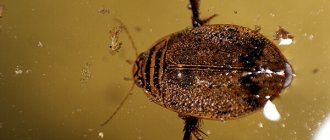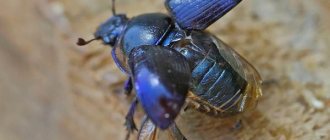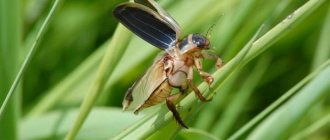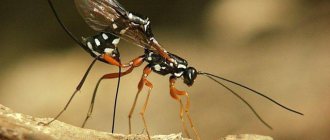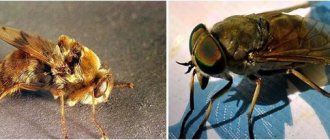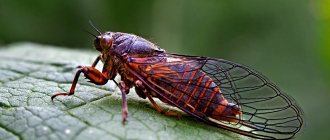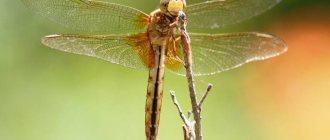The Great Oak Longhorned Beetle is one of the most beautiful and largest woodcutter beetles, with Mediterranean roots. The insect can be found in European countries and Africa. It is also widespread throughout our country, in Belarus, Ukraine and the Caucasus. The longhorned beetle has become popular not only because of its large size (its body length can reach up to 6.5 cm), the insect is one of the most dangerous pests of oak wood. This article will tell you who the oak longhorn beetle is, or as it is also called the black oak longhorned beetle.
Description and features
These insects are mostly harmless in themselves; they feed on plants, mainly of the woody variety. But sometimes they look very menacing. The most striking feature is the long mobile whiskers, their size is 2 or even 5 times the length of the body. At the base of the antennae are the insect's eyes. The mustache is an organ of smell and touch.
What all these beetles have in common is an elongated body structure, although, depending on the species, the shape itself can be wider at the sides and more elongated. The body structure of adult individuals can be divided into three main parts: head, chest and belly. The limbs are divided into 5 components - pelvis, trochanter, femur, tibia and tarsus.
They have 3 pairs of legs, hard chitinous elytra, and some have large jaws. The abdomen is soft, divided into segments, most often into five. Their head is round in shape and sometimes fits quite tightly into the prothorax.
Males differ from females by having longer mustaches, the upper jaws of males are also more developed, the abdomen is sharper, and they are often painted a different color. Their body shape is more flattened and wider. These beetles are characterized by such a concept as sexual dimorphism. This is when females and males look different, as if from different species.
Many longhorned beetles make sharp sounds, such as squeaking or grinding sounds. This occurs due to friction of the prothorax rib against the rough surface of the mesothorax, or friction of the thighs of the hind legs against the elytra. They make such sounds when there is a threat of attack from enemies. Most likely to scare them away.
Their coloring varies greatly. It consists of the color of chitinous wings and hairs on the body. The colors delight with their diversity. Light shades - creamy yellow, salad, lemon, pink.
Dark shades - brown, purple, black. Combined coloring is very common - stripes, spots and other patterns, sometimes of a complex and ornate shape. All external differences between beetles depend on their habitat and species affiliation.
Professionals will help you fight the longhorned beetle
To treat the external surface of a wooden house with Clipper, you can invite a specialist with a cold or hot fog generator. This treatment allows you to evenly cover the entire treated surface with drops of insecticide, spending less time on it and saving on consumables.
Be wary of the proposal to treat your house against insect pests with a combination of Clipper and Bi-58. The poisonous drug Bi-58 is a bright blue liquid containing phosphoric acid esters, which leaves irremovable stains and an ineradicable chemical odor after its use. It is strictly forbidden to use this drug for treating interior spaces.
In the market for services offered by professionals for the destruction of wood-eating insects, the following areas deserve attention:
- Fumigation with Phosphine;
- Microwave disinsection.
- XILIX GEL
These methods have their advantages and disadvantages. They can only be used by specialists who have undergone special training, confirmed by the appropriate certificate.
Kinds
Very rough estimates indicate about 26,000 species of these creatures, but these data often change. Almost every year new species are discovered from different places, mainly from the tropics and areas close to the equator. However, new species also appear in civilized Europe, exotic Asia and advanced America.
There are 583 species of them on the territory of Russia. Despite their diversity and abundance, these insects have been well studied by scientists. Most are average in size for beetles. But there are also giants among them. For example, the titan lumberjack, which lives in North America, reaches 19-22 cm in length.
There is another large species in South America - the Brazilian bigtooth woodcutter, the size of which can be 17-18 cm. The longhorned beetle from Fiji is the third largest of the large beetles known at the moment. Its size reaches 15 cm.
Lumberjack bigtooth
Of the European beetles, the largest at the moment is the carpenter's longhorned beetle, it is about 6 cm long. Russia also has a large representative of this species - the Ussuri relict longhorned beetle. He grew to 11 cm.
Relict barbel
There are 11 subfamilies belonging to the barbels. Let's talk about some of them. Their names: true longhorned beetles, laminae, longhorned beetles, parandrins, prionine longhorned beetles, spondylidins. Lamiinae include more than 13,000 species of beetles, many of which look elegant in appearance. For example, some have transverse stripes of black and greenish color along their wings.
Prionins include 1000 species. This is one of the oldest beetles. Found everywhere on earth except cold polar regions. The size varies greatly, from 2 mm to 178 mm, but mostly these are large beetles, sometimes even up to 22 cm.
Painted in brown, black, brown tones. It is to this subfamily that the giants among beetles belong: the titan woodcutter, the Brazilian bigtooth woodcutter and the Ussuri relic woodcutter.
Parandrins number 50 species and live in the tropics and subtropics. They are atypical for the family, as they have very short antennae, which are more reminiscent of staghorns. The color of their hard wings is usually red-brown or black.
The barbels or lepturines are a family of 100 genera and 2500 species. Small beetles, the wings are colored with yellow and black stripes.
Spondylidins include more than 100 species. These are nocturnal and crepuscular representatives. Their whiskers are also not very long, their size is smaller than their body. The color of the wings is blue-black or black-brown.
This longhorned beetle in the photo resembles a picture from Egyptian frescoes. It is very beautifully outlined, there is an interception in the middle of the body, the wings have a noble matte tint, a little like a bronze vase. The whiskers are segmented, the paws are very elegant. Just a model for a coat of arms.
Notes
- ↑
- ↑
- Striganova B. R., Zakharov A. A.
Five-language dictionary of animal names: Insects (Latin-Russian-English-German-French) / . - M.: RUSSO, 2000. - P. 152. - 1060 copies. — ISBN 5-88721-162-8. - ↑
- ↑ Cherepanov A.I.
Longhorned beetles of Northern Asia (Cerambycinae) / Violovich N.A. - Novosibirsk: “Science”, 1981. - T. II. - pp. 175-179. — 215 p. — 1000 copies. - ↑ Plavilshchikov N.N.
2 // Fauna of the USSR. Coleoptera. Woodcutter beetles / Zernov S. A. - Moscow-Leningrad: Academy of Sciences of the USSR, 1940. - T. XXII. - pp. 507-512. — 785 p. - (22). — 1000 copies. - ↑
- Kostin I. A.
Dendrophagous beetles of Kazakhstan (bark beetles, woodcutters, borers). - Alma-Ata: “Science”, 1973. - P. 242-243. — 287 p. — 1400 copies. - ↑ Identifier of forest pests / Ilyinsky A. I. - Moscow: Selkhozizdat, 1962. - P. 317. - 392 p.
- Key to insects of the Russian Far East. T. IV. Reticuloptera, Scorpioptera, Hymenoptera. Part 5 / under general ed. P. A. Lera. - Vladivostok: Dalnauka, 2007. - P. 675. - 1052 p. — ISBN 978-5-8044-0789-7.
Lifestyle and habitat
The longhorned beetle lives throughout the planet where there are forests. Their distribution depends on the availability of food - mainly trees. The exceptions are the Arctic and Antarctic, precisely because of the lack of food supply.
They are quite active in their lifestyle. They crawl, many very quickly. Some of them can fly. If you pick up a beetle, it makes a characteristic chirping sound. Their lifestyle depends on the climate and habitat.
In the southern regions, these insects “take wing” from mid-spring. Central Asian beetles begin to fly closer to autumn. Some are active during the day, feeding mainly on flowers that open during the day. Others are active at night. Their food does not hide in the dark.
Both nocturnal and daytime beetles find hard-to-reach places to rest or mate. Depending on the size, the flight range is determined. The larger the beetle, the less it flies and the more it crawls. They lead a very secretive lifestyle. Seeing an adult beetle in the forest is a real gift for an entomologist and an alarming signal for a forester.
Spreading
The oak barbel inhabits all of Europe and a small part of South-West Asia. Its habitat covers the territory from Saudi Arabia to the Mediterranean Sea and to the south of Sweden, from France to Western Ukraine. The insect can often be seen in the Caucasus.
The beetle has perfectly adapted to temperate climates and is able to withstand severe frosts. Despite its wide habitat, its colonies can only be observed where there is a sufficient food supply. Insects love places warmed by the sun and prefer unshaded trees.
Nutrition
What the longhorned beetle eats depends on its habitat. Adult beetles feed on pistils and stamens of flowers, young bark and leaves of bushes and trees. Pieces of fallen or healthy bark, petioles, plant sap, pulp of cacti or other plants - this is what the longhorned beetle feeds on.
That is, an adult beetle is almost harmless. But the larva of the longhorned beetle is a scourge for trees, wooden buildings and wooden objects. They develop in trees and feed on wood, causing enormous harm to forests on the planet.
Many beetles were divided into subspecies precisely due to the choice of the type of tree they chose to feed their larvae. For example, the oak longhorned beetle prefers hardwood trees, oak, for example.
It can settle in oak stumps, as well as in places where the tree is damaged. This beetle is medium in size, 3 to 6 cm, black with a brown tint, and glossy like resin. The elytra are reddish at the tips. In addition to oak, he chooses beech, hornbeam, elm, and walnut for feeding future larvae.
The black or pine longhorned beetle prefers to choose coniferous trees. It is also called the ship beetle. Its larva inexorably destroyed even ready-made ship structures if they were built from infected pine. He himself feeds on pollen, pine needles and leaves.
The beetles that prefer coniferous trees for their clutches - larch, spruce, pine, also include the flat beetle, with a purple color.
The purple longhorned beetle itself feeds on the soft bark of young trees and tender young needles. But its larva causes damage to trees on an almost industrial scale. They continue to destroy wood, even harvested and cut for consumption. They also love to live close to humans, destroying buildings.
Lifestyle
Large oak longhorn beetles emerge from their secluded hiding places at the end of May. They are especially active at the beginning of summer, preferring to fly during the daytime. Their favorite habitats include isolated trees or oak forests.
Interesting!
More often, insects settle on trees that secrete a special liquid - gum, which they like to feast on. Having settled in the wood of a tree, the beetles gnaw long tunnels in it, which causes the plant to “cry” (secrete sap).
Much less often, large oak longhorn beetles can be found on walnut or apple trees. They do not have much love for ash, hawthorn and hazel.
Reproduction and lifespan
The entire breeding process takes place in a quiet and calm place, somewhere higher. On the top of a tree, on the roof. Females secrete a special fluid (secret) that attracts a partner. Mating takes about 30 minutes. The female who has received attention remains under the protection and supervision of the male, who accompanies her until the eggs appear.
At the end of the mating season, the male dies, and the female survives it to lay eggs. The female beetle lays up to 100 eggs in cracks in trees and wood parts. She chooses the laying site by smell. Having created a clutch, the insect no longer shows any concern for the offspring.
Larvae emerge from the eggs, then pupae, and only after a few years do they eat through the passages in the tree and crawl out. The larvae themselves, growing, almost reach the length of an adult beetle. The entire life cycle consists of several stages: egg, larva, pupa, adult.
Sometimes longhorned beetles prepare in advance a place for feeding and development of future larvae. They choose small trees and eat the bark around the perimeter in the form of a ring, closer to the root. As a result, the tree begins to slowly die. And the deposited larvae complete the destructive process.
They make a loud crunching sound as they bite into the wood. Sometimes in a dry forest you can even hear this characteristic sound. The larvae are very hardy. They tolerate any unfavorable conditions and live in dry and nutrient-poor trees for many years.
They have a light body color, from white to yellowish. The body itself is soft, slightly flattened, with a well-developed cephalothorax. It is equipped with powerful jaws directed straight forward, which can perform both cutting and chewing functions.
The life cycle of an adult is quite short. The beetle emerges from the pupa in early spring, although for this the larva must have time to “pupate”. If spring is far away, the pupa burrows into the core of the tree and hibernates, waiting for the onset of warmth.
Development
The female lays up to 130 eggs during her life, placing them one at a time in the crevices of the bark of fallen or dead trees standing on the roots.
The egg is 1 millimeter long and half a millimeter across. Two weeks later, at the end of embryonic development, the hatched larvae penetrate into the thickness of the bark or shallowly under it, laying winding longitudinal passages that are not imprinted on the surface of the wood. The passages are clogged with fine drill flour, which is processed bark. Along its length, the larval passage has unequal width: it can narrow or expand, taking the shape of platforms. Larval development ends in the late spring of the first or second year of life, when the last instar larva builds a vertically oriented chamber 14-21 mm long and 5-8 mm wide in the thickness of the bark of the food tree, in which pupation occurs. The fourth (last instar) larva, which builds the cradle, reaches 10–18 mm in length. To the surface of the bark from this chamber the larva also makes a passage (up to 6 mm long), through which in the future the adult beetle leaves the cradle. In red-breasted longhorned beetles, a thin layer of bark remains between the end of this passage and the surface. The formed pupa varies in length from 9 to 16 mm; it is located in the cradle with its head up and develops into an adult after 15-17 days; The emerging beetle can be 6-16 mm in length.
Benefits and harms for humans
When the larva gets out, a hole is formed in the tree, from which small sawdust spills out. This way it becomes clear where this harmful beetle lives. Sometimes they eat the tree from the inside until it is completely rotten, and it collapses.
Some beetles, such as the house beetle, have become unpleasant neighbors for humans. They are rare in nature, but they thrive in wooden houses. The home's upholstery, floors, wood window frames, ceiling rafters and roof can all be damaged if this insect infests. They lay larvae that destroy anything wooden.
Even furniture, beds, tables and chairs, may suffer from such proximity. Beetles prudently lay eggs in hard-to-reach places - deep cracks in wooden products. After 2 weeks, larvae emerge from them, which begin their invisible destructive activities. If these items are not processed in time, after a while everything will turn into dust.
There are, however, individuals of the woodcutter beetle that are not dangerous, but, on the contrary, are beneficial. For example, the gray longhorned beetle is not so harmful to the forest. It only affects old and dying trees, which speeds up the transition of loose wood into humus. Many beetles act as pollinators of flowering plants, providing more benefits than classical pollinators.
Enemies of the insect
In nature, the oak barbel has many enemies. The woodpecker is considered especially dangerous because it feasts on beetle larvae living in wood. Some insects belonging to the order Hymenoptera (for example, encyrtids) can parasitize beetle eggs. Some species of predatory beetles prey on longhorned beetle larvae:
- toddler;
- nutcracker;
- moth
How to get rid of barbel
The longhorned beetle at home is one of the most terrible enemies of man, if not the most dangerous. Its larvae are hardy, voracious, and are not immediately detected. Therefore, you need to know some rules on how to get rid of the longhorned beetle so as not to be left homeless.
- When choosing wood, be sure to check whether it has been treated with an antiseptic.
- When constructing a building, use special finishing products for wood with an antiseptic. They will prevent bugs from invading.
- If you have bugs, be sure to carry out emergency treatment with chemicals. These are bromomethyl, zinc chloride, sublimate. Moreover, such treatment must be carried out 2-3 times a year. The larvae are tenacious, and prevention is a must. It is important to remember that the process must be carried out under the control of the relevant services. It is better to call specialists from the sanitary and epidemiological station for this purpose.
You should also contact specialists if you decide to fumigate against beetles, treat with poisonous gas, or install poisonous baits. All these methods require a careful professional approach.
You can treat it with dry steam or, conversely, by freezing. Only these methods are difficult to implement at home. And they are not safe. Therefore, they are used in production, and only in strictly designated places.
A modern method of getting rid of house beetles is microwave irradiation. A special device heats the wood even in hard-to-reach places, destroying the larvae. The advantage of this method is safety for people and buildings. It happens that some affected parts are easier to cut out and replace with new, undamaged and treated ones.
Where can I meet you?
The longhorned beetle can live and reproduce not only in various tree species, but also in shrubs and herbaceous plants. Longhorned females lay their eggs in a crack in tree bark, in depressions on branches, trunks or stems. Moreover, the pests make these cracks and gouges themselves.
Lumberjacks can “visit” you at your dacha, and the forestry industry can “boast” of such guests. In country houses, the objects of pest attack are furniture, boards and other wood products.
Interesting Facts
- Despite its powerful jaws, capable of chewing through a pencil, the beetle's bite is not dangerous to humans. He is not capable of causing him serious harm.
- An adult longhorned beetle, even a giant one, eats very little. Sometimes he lives only thanks to the reserves that he accumulated as a larva. Females feed more than males to ensure normal egg maturation.
- In her territory, the female most often has no rivals. She secretes a special pheromone that attracts males and repels other females.
- A grown beetle lives for one summer season, a maximum of 2-3 months, and the larva is much longer, for years, in some species up to 10 years.
- Some futurists predict that in the future we will eat wood. If you study and use the digestive system of the longhorned beetle, it is quite possible to do this. Its intestines are equipped with special bacteria that process cellulose into easily digestible carbohydrates. Periodically, the larvae process these bacteria, obtaining additional nutrients from them. Waste-free production.
- It may seem strange, but not butterflies and bees, but the longhorned beetle is inextricably linked with flowering plants. They spend most of their short lives on flowers. And because of their size, they pollinate a large surface. Thanks to his taste preferences, some plants have been preserved and survived in nature.
A little bit of biology
Longhorned beetles have fairly small sizes (from one to several tens of millimeters), a flat body and mustaches, which are the main organ of smell.
The color of lumberjacks is usually brown or dirty gray; less commonly, the longhorn beetle is black. The photo allows you to examine the insect in more detail. The larvae of the pest are characterized by particularly powerful jaws, thanks to which they can handle both hard wood and soft metal with a cable-type coating. However, the beetles do not eat the latter so readily, preferring wooden structures and stacked boards.
The female barbel lays her eggs (from 200 to 400 pieces) in recesses or cracks in the tree, and after 7-14 days the larvae are born, which instantly activate the process of destroying the tree.
It is worth emphasizing that it is almost impossible to immediately notice a tree disease, since the larvae lead a hidden lifestyle. So, you can understand that your wooden house has succumbed to the harmful effects of longhorned beetles only when the real results of their work (destroyed and loosening wood) are visible.
Behavior
The oak longhorned beetle is a sedentary insect. It makes its flights at night and only over short distances. It is almost impossible to see it during the day. Usually the flight of the barbel occurs in order to find a new food tree.
The beetle feeds on leaves and juice flowing from damaged areas.
To get its juice, it gnaws through a tree with its large jaws. The favorite trees of the longhorned beetle include sessile and common oak. It can also be seen on walnuts, chestnuts, elms and beeches.
Natural enemies are all insectivorous birds. An alarmed barbel makes creaking sounds, rubbing its wings against the pronotum.


